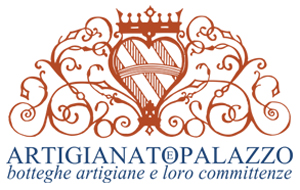In a climate of renewed interest in handicrafts and in the sometimes somewhat crowded context of fairs, awards and celebrations, it is with pleasure and interest that we welcome an exhibition such as ARTIGIANATO E PALAZZO: with pleasure because it offers the opportunity to appreciate and compare handicraft products of the highest quality and intrinsic artistic value; but also with interest because, beyond its aesthetic values, the exhibition represents a concrete contribution to the valorisation of handicraft work and the diffusion of this value also abroad.
A value that is certainly very Italian, not based on brands of origin or fashionable griffes, but on the peculiarities of a workmanship that has its roots in the territory and in popular traditions and that is able to interpret this cultural heritage, giving us artefacts that are up-to-date in taste or function of use.
In support of such an authentic expression of ‘Made in Italy’, the I.C.E. has long been committed – also in collaboration with other institutions – with a programme of actions tailored to the characteristics and specific needs of craft businesses.
This is because, in addition to strengths such as creativity, manual skills, and the continuous search for customisation of the object, craft production still has weaknesses, mainly linked to the production structure and company size, which condition the presence of craft businesses on international markets and expose them more to foreign competition.
Hence the need to design ad hoc interventions, suitable for enhancing the production and commercial potential of artisan companies, in the awareness of supporting not only a relevant economic reality, but also an important cultural heritage of our country.
We wish the ARTIGIANATO E PALAZZO exhibition continued success, because it constitutes a moment of reflection and in-depth study on the role of Italian craftsmanship and a stimulus to its greater valorisation.
Gioacchino Gabbuti
Director General I.C.E.
Institute for Foreign Trade
For the 5th edition of ARTIGIANATO E PALAZZO
We have arrived at the 5th edition of ARTIGIANATO E PALAZZO with the approval and growing support of hundreds of artisans who still resist and struggle to save their identity and that quality and refinement that only they can achieve: an exhibition that is different from the others and that wants to represent a moment of true insight into the “minor arts”.
Considering craftsmen an active part of the cultural fabric at the basis of our civilisation, we have founded the Giardino Corsini Cultural Association with the precise task of promoting and helping to organise this endangered treasure.
All conservators of ancient objects and monuments know how precious the intervention of a true craftsman is in the maintenance and restoration of works of art: it is unthinkable to do without the atavistic taste, patience and passion that are the most important traits of a craftsman’s activity consolidated through generations or revolutionised – without dismay – by new technologies and the crossing of experiences.
This year’s ‘Prince’s Exhibition’, organised together with the Friends of the Costume Gallery of Palazzo Pitti, is dedicated to embroidery, to be exact to the magnificent collection of antique pieces that an exceptional Florentine artisan – Loretta Caponi – in decades of painstaking and loving research has managed to create.
This year, we would like to thank Caterina Romig Ciccarelli and Valentina Grazzini, Marco Baldassarri and Michele Masi who helped us set up the Association, Maddalena Torricelli who took care of our Press Office, and the ladies of the Administration Manola Chemeri, Fiorella Fanfani and Elmira Gorini who, together with Giuseppe, Maurizio, Romeo and Giovanni, have followed us with kindness, patience and efficiency.
We would also like to thank the Cassa di Risparmio di Firenze for always and faithfully being at our side, year after year.
Giorgiana Corsini and Neri Torrigiani
Invitation to the Pitti Palace Costume Gallery
As on other occasions when the history of dress was linked to the themes of living and contemporary creativity, the Costume Gallery wished to be present at this edition of ARTIGIANATO E PALAZZO – through the Association of Friends who follow and support it – by signing a patronage that made it possible to set up the tasty themed exhibition with rare pieces from the Caponi collection. This is also an effective way of keeping the spotlight on the Galleria di Palazzo Pitti, whose rooms are currently undergoing extensive restoration work and bringing the installations up to standard. At the reopening, scheduled for the end of the year 2000, it will therefore be possible to retrace the history of dress and its historical and sociological implications – from the 18th century to the present day – through a layout that has been perfected in terms of display techniques and scientific information. The rooms of the Museum are those of the Palazzina della Meridiana, overlooking the Boboli Gardens, which were first the home of the Lorraine family and then of the Savoy family, and which will recover their original furnishings for the occasion, thus making it possible to interpret the evolution of dress within a coherent historical context. That is to say, it will be possible to reconstruct – through the masterpieces of tailoring that also involve the artistic and literary spheres – the sequence of tastes and styles intimately connected with the evolution of the facts of history and, in many cases, with the free impulses of a fantasy in search of sumptuous escapism. As one can imagine, the reopening of the Galleria del Costume will be the continuation of an adventure of taste embarked upon by Cristina Aschengreen Piacenti and now consolidated in the certainty of returning to the public the results of a survey and collection among the first in Europe; What follows is a warm invitation to the guests of the Giardino Corsini who, admiring the graces and artifices of modern craftsmanship together with the embroidered intimacies of an important Florentine collection, I hope will keep in their memory this brief viaticum addressed to the Boboli hill and to the next journey that the Costume Gallery of Palazzo Pitti is reserving for enthusiasts of history and its mysterious and fragrant remains.
Carlo Sisi
Director of the Pitti Palace Costume Gallery
Embroideries on grass: the Loretta Caponi collection
Loretta Caponi’s richly varied and beautiful collection, assembled over several decades and continually updated with great rigour, skill, self-sacrifice and love, brings together a large number of ‘masterpieces’ ranging from personal and household linen to clothing and related accessories from the 19th century to the present day.
The Caponi collection has a singular history: Loretta’s passion for the art of embroidery and lacework has gradually extended to all those artefacts made by skilled female hands, expressions of a great and silent art, so that the main purpose of this collection has been to remove from silence and oblivion now dusty splendours, specimens of life and everyday events that human carelessness and incompetence would have caused to be lost forever.
Loretta Caponi’s high degree of artistic sensitivity, a keen eye as a true researcher of works of art, her vast culture and technical expertise in the field are the basis of the exceptional collection she has put together, which excels nationally in terms of quality and number of specimens, including unusual and rare ones, painstakingly and technically researched in every corner of Europe.
Unique pieces of 16th-century embroidery and white-on-white embroidery designed to adorn night and day shirts, trunk covers, underskirts, sheets and pillowcases, tablecloths and curtains, made in Italy and Europe; lace from the prestigious manufactures of Venice, Burano, Milan, Genoa, Cantù, dating from the 17th to the 20th century, as well as lace from Bruxelleles, Aleçon, Valenciennes, Lille, Honiton, to name but a few, and a vast repertoire of popular lace in the form of samples, alongside the designs drawn on paper.
Paolo Peri
The Cassa di Risparmio di Firenze Prize
Benvenuto Cellini’s Perseus lends its image and name to the Prize that the Cassa di Risparmio di Firenze awards to the ARTIGIANATO E PALAZZO exhibitor most appreciated by the public.
Cellini’s masterpiece, now under restoration thanks to the intervention of the Cassa di Risparmio di Firenze, is the symbol of that encounter between humanism and technical evolution that made the Florentine Renaissance one of the founding episodes of European culture and history. An encounter that had precisely in the ‘botteghe’ one of its essential places.
And it is to this great tradition of Florentine workshops that the award is intended to refer, offering recognition to those who know how to keep alive the interest in the artisan ‘workshop’, for a place, that is, where quality is at home and where the final product is the bearer of culture. An artisan culture that the Cassa di Risparmio di Firenze, thanks to its close ties with the territory, knows well and which, in its banking activities, it actively supports.
In the sign of Perseus, moreover, the Cassa di Risparmio di Firenze has set up an important communication campaign aimed at affirming the enduring vitality of the encounter between technology and humanism in its own banking activity. In its planning efforts, as in its daily operations, the Cassa has in fact as its primary objective the global quality of service as a result of the correct fusion of technology and human capabilities.
Aureliano Benedetti
Chairman of Cassa di Risparmio di Firenze S.p.A.


